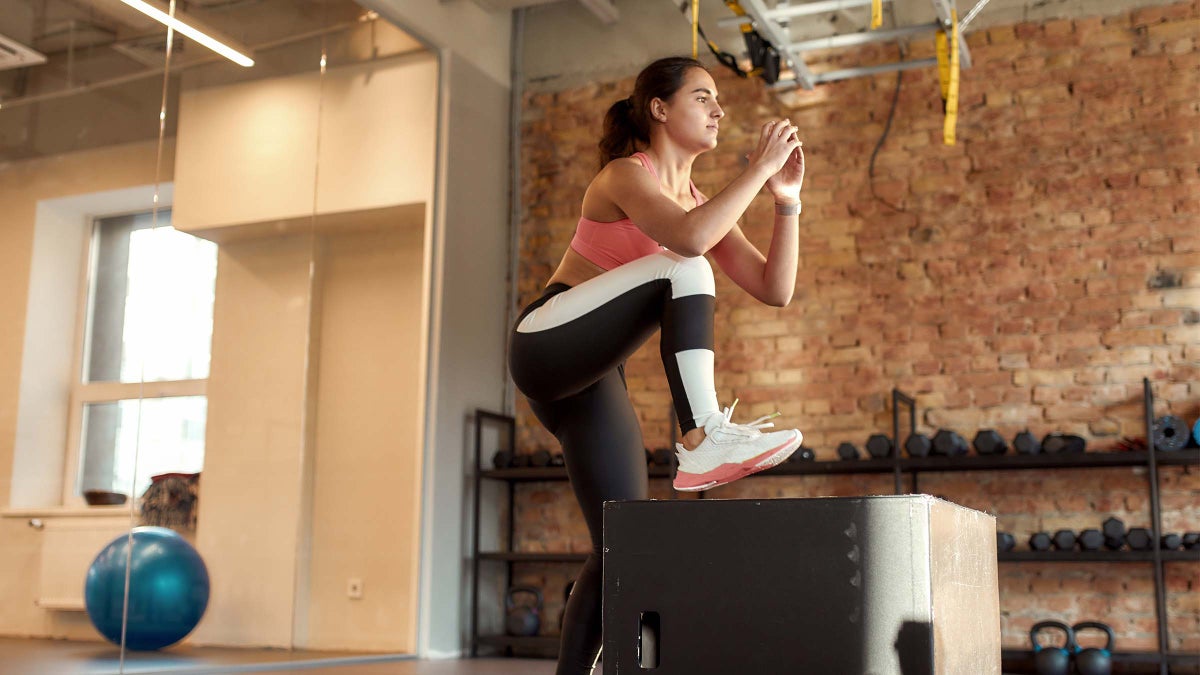Products You May Like
Get access to everything we publish when you
sign up for Outside+.
Wondering if your cardiovascular fitness is holding you back from peak hiking performance? A step test is an excellent way to measure cardiovascular endurance. The YMCA three-minute step test measures how effectively your heart recovers after performing three minutes of step-ups to a 12-inch step at a specific cadence.
After the test is complete, you’ll measure your heart rate for one full minute. Then, you’ll cross-reference the number of beats you record in the chart provided to give you some key insights into your fitness level. The results will yield some useful information that you can use to adjust your training program leading into a backpacking trip or upcoming hike.
The test is easy to set up, quick to perform, and can be done anywhere using minimal equipment.
The Test
Before starting the test, you’ll need to gather a few items.
- A 12-inch step. For this, you can stack up weights, use a plyometric box, bench, stool, or steps in your home.
- A stopwatch. A cell phone timer or sport watch works great for this.
- A metronome. You can find free metronomes in the app store on your device. This part is crucial since the metronome sets the pace for the test.
Set the metronome to 96 beats per minute. Before beginning the test, take some practice steps with the metronome to get a feel for the rhythm. Complete one step movement with every metronome beat. Step with the left foot up, then up with the right foot—each foot must be completely on the step. Stand up tall on the step to complete the repetition; no hunching over. Next, step down with the left and then down with the right foot. Think “up, up, down, down” for each movement, keeping with the beat of the metronome for each up and down. With every tick, a foot should either be landing on the step or the floor.
Once you are comfortable with the pace, press start on your timer set for 3 minutes. Move in time with the metronome for the duration of the test.
Immediately following the three minutes, sit down and begin to take your radial pulse. Turn your hand so your palm is facing up. On the outside of your forearm about an inch down from your thumb joint, you’ll find a groove between the two arm bones. Place your index and middle finger in this groove with enough pressure to feel your pulse. Using the timer again, count the heartbeats for a full 60 seconds. For the most objective results, taking a manual heart rate reading will be more accurate than a smartwatch or heart rate monitor.
Reference your recorded heartbeat with the charts below to see how well you performed. (Notice there is one chart for men and one for women.)
A normal heart rate range can vary from 60 to 100 beats per minute, but toward the lower end is generally considered more healthy. A strong score on this test indicates your heart can quickly recover from exercise, which is less stressful for the heart. A poor score means your heart is working less efficiently—and is a good indication that you should focus on cardio in your training routine.

Ratings for Women, Based on Age
| 18-25 | 26-35 | 36-45 | 46-55 | 56-65 | 65+ | |
| Excellent | 52-81 | 58-80 | 51-84 | 63-91 | 60-92 | 70-92 |
| Good | 85-93 | 85-92 | 89-96 | 95-101 | 97-103 | 96-101 |
| Above Average | 96-102 | 95-101 | 100-104 | 104-110 | 106-111 | 104-111 |
| Average | 104-110 | 104-110 | 107-112 | 113-118 | 113-118 | 116-121 |
| Below Average | 113-120 | 113-119 | 115-120 | 120-124 | 119-127 | 123-126 |
| Poor | 122-131 | 122-129 | 124-132 | 126-132 | 129-135 | 128-133 |
| Very Poor | 135-169 | 134-171 | 137-169 | 137-171 | 141-174 | 135-155 |
Ratings for Men, Based on Age
| 18-25 | 26-35 | 36-45 | 46-55 | 56-65 | 65+ | |
| Excellent | 50-76 | 51-76 | 49-76 | 56-82 | 60-77 | 59-81 |
| Good | 79-84 | 79-85 | 80-88 | 87-93 | 86-94 | 87-92 |
| Above Average | 83-93 | 88-94 | 92-88 | 95-101 | 97-100 | 94-102 |
| Average | 95-100 | 96-102 | 100-105 | 103-111 | 103-109 | 104-110 |
| Below Average | 102-107 | 104-110 | 108-113 | 113-119 | 111-117 | 114-118 |
| Poor | 111-119 | 114-121 | 116-124 | 121-126 | 119-128 | 121-126 |
| Very Poor | 124-157 | 126-191 | 130-163 | 131-159 | 131-154 | 130-151 |
Want to improve your score?
There are numerous ways to improve cardiovascular efficiency for hiking, from running to focused workouts. Doing step-ups as in this test is also useful, because it helps improve your cardiovascular efficiency in a manner that is specific to the needs of a hiker and improves your lower leg strength and endurance.
The following workout is an adaptation of this test that will improve your cardio and raise your score on future step tests. By adding in weights, you’ll increase the working demand on the heart, which helps strengthen the heart muscle. Having a strong heart ultimately means less huffing and puffing and more enjoyment on hikes.
Using a 12-inch step, hold a pair of 10-pound dumbbells or wear a weighted backpack while performing 15 step-ups with the right leg leading, followed by 15 step ups with the left leg leading. Rest until you feel recovered and repeat for 2 more rounds.
Lee Welton is a physical therapist assistant and personal trainer in Southeast Idaho. He thru-hiked the Pacific Crest Trail in 2018 and has trekked through the Dolomites in Italy. He can typically be found hiking and exploring the trails in Idaho and Wyoming. For more information, videos, and resources from Welton, visit trailsidefitness.com.
